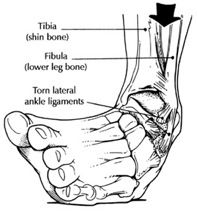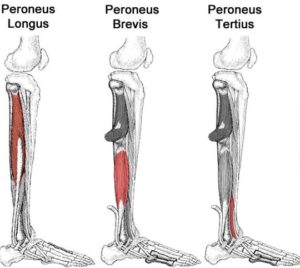 I am referring to that ankle – or ankles – that ever since you ‘rolled’ and injured it 10 years ago, it has never been the same. This problem can be fixed more easily than you think!
I am referring to that ankle – or ankles – that ever since you ‘rolled’ and injured it 10 years ago, it has never been the same. This problem can be fixed more easily than you think!
Big words.
The most common ankle injury is called a plantar flexion inversion injury. Sounds like big words, but what it describes is that painful injury where you land unevenly, or on the opponent’s foot, and your foot ‘rolls’ under you. It is called ‘rolling your ankle’.  It is followed by serious pain. If you have done it badly the ankle, particularly the outer ankle, will commence swelling immediately, might turn black and blue over the next few days and it generally takes 6-12 weeks to recover. If you are really unlucky you rupture a few of those ligaments on the outside of the ankle while you are at it.
It is followed by serious pain. If you have done it badly the ankle, particularly the outer ankle, will commence swelling immediately, might turn black and blue over the next few days and it generally takes 6-12 weeks to recover. If you are really unlucky you rupture a few of those ligaments on the outside of the ankle while you are at it.
It never really got better.
Many times over the years I have heard patients refer to their ankle as ‘weak’. What they go on to describe is the fact that ever since they rolled or injured that ankle years or months ago, it has never been the same. Sure the swelling went down eventually and they resumed sport but the stupid thing wants to roll all the time, so easily!
I have seen many examples where weakness is so apparent that the person will roll, or fall, as the ankle ‘gives way’ on a daily basis. Stepping on something as subtle as a pebble can cause the ankle to ‘let go’.
What is happening?
When you roll your ankle you basically stretch the joint through a range of movement that it wasn’t meant to go through. This either sprains or tears the ligaments that are meant to hold the thing together. In most cases it sprains them. They do recover, but take a long time – between 3-6 months. Now most therapies are geared toward reducing the inflammation and helping the ligaments heal. What most therapies do not address are the peroneal muscles and this is why the ankle ‘weakness’ goes on forever. Let me explain.
What are the peroneal muscles?
These are the muscles on the outside of your lower leg. There are three of them and they start near the knee and run all the way down the outside of the leg around the ankle and under the foot. These muscles basically stabilise the ankle. They are packed  full of little receptors (called proprioceptors) that are constantly sending messages back and forth to your cranium to tell you where your foot is. So if you have fit, healthy ankles, never been injured and you are waltzing down the street and step half off the kerb because the blonde in the red ute caught your eye…
full of little receptors (called proprioceptors) that are constantly sending messages back and forth to your cranium to tell you where your foot is. So if you have fit, healthy ankles, never been injured and you are waltzing down the street and step half off the kerb because the blonde in the red ute caught your eye…
Then as your ankle begins to ‘roll’ the receptors in the peroneal muscles sense this and immediately correct your foot posture, saving you from landing on your face. With the blonde watching. You only look like half a fool because you stumbled but didn’t fall.
What do the peroneal muscles have to do with my weak ankles?
So imagine six months, or even six years ago, you badly rolled your ankle playing basketball. It healed but has been weak ever since. It has been weak ever since because when you rolled your ankle, you not only strained the ligaments in the ankle and you not only acquired painful bruising for 12 weeks, you also strained the peroneal muscles up the side of the leg. The problem with this is that the myofascial mechanism in the muscles has a memory. When the muscles are strained they develop little restrictions that stay – permanently. These little restrictions in the muscle muck up the proprioception.
Can you see where I am going.
So with poor proprioception, let’s call it feedback between brain and foot, let’s imagine the same scenario. So the blonde in the red ute has caught your eye, you step half off the kerb, your ankle begins to roll but the feedback from the peroneals to the brain is late, the foot does not correct itself and you are on your face.
A wry smile as she drives away is all you get for your pain.
Can it be fixed?
Absolutely.
Introduce the magic of Myotherapy. I have seen this scenario so many times it’s amazing. Doctors, physios, sports masseurs simply do not realise or do not know how to fix this. Some simple and skilful manipulation on exactly the right parts of the lower leg will, in my experience, always improve and in most cases resolve the ankle weakness. It is amazingly simple and effective.
Don’t risk landing on your face, get some of the RIGHT treatment today and correct those weak ankles. So easy.
I bet you know someone in this boat, use your favourite media button below and share this article, don’t keep it to yourself! If you like the technical stuff then read the professional version of this article ‘Peroneal Proprioception – Be the guru on ankle stability‘.
Stay on your feet,
– Tim


